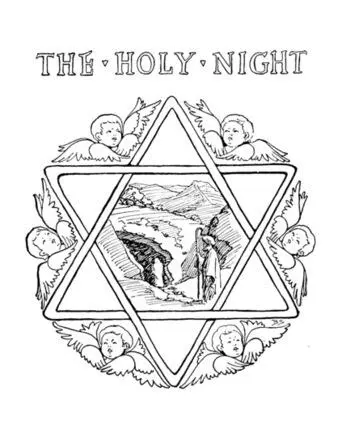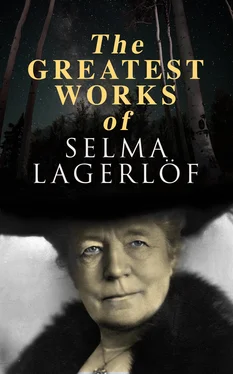After that he walked farther up the strand. He knew perfectly well that the sorrows of the birds do not last long, and he wanted to part with them while they were still sad at losing him.
As he crossed the shore meadows he turned and watched the many flocks of birds that were flying over the sea. All were shrieking their coaxing calls—only one goose flock flew silently on as long as he could follow it with his eyes. The wedge was perfect, the speed good, and the wing strokes strong and certain.
The boy felt such a yearning for his departing comrades that he almost wished he were Thumbietot again and could travel over land and sea with a flock of wild geese.
Table of Contents
The final e is sounded in Skåne, Sirle, Gripe, etc.
The å in Skåne and Småland is pronounced like o in ore.
j is like the English y . Nuolja, Oviksfjällen, Sjangeli, Jarro, etc., should sound as if they were spelled like this: Nuolya, Oviksfyellen, Syang [one syllable] elee, Yarro, etc.
g , when followed by e, i, y, ä, ö , is also like y . Example, Göta is pronounced Yöta.
When g is followed by a, o, u , or å , it is hard, as in go.
k in Norrköping, Linköping, Kivik (pronounced Cheeveek), etc., is like ch in cheer.
k is hard when it precedes a, o, u , or å . Example, Kaksi, Kolmi, etc.
ä is pronounced like ä in fare. Example, Färs.
There is no sound in the English language which corresponds to the
Swedish ö . It is like the French eu in jeu.
Gripe is pronounced Greep-e.
In Sirle, the first syllable has the same sound as sir , in sirup.
The names which Miss Lagerlöf has given to the animals are descriptive.
Smirre Fox, is cunning fox.
Sirle Squirrel, is graceful, or nimble squirrel.
Gripe Otter, means grabbing or clutching otter.
Mons is a pet name applied to cats; like our tommy or pussy. Monsie house-cat is equivalent to Tommy house-cat.
Mårten gåskarl (Morten Goosie-gander) is a pet name for a tame gander, just as we use Dickie-bird for a pet bird.
Fru is the Swedish for Mrs. This title is usually applied to gentlewomen only. The author has used this meaning of "fru."
A Goa-Nisse is an elf-king, and corresponds to the English Puck or Robin
Goodfellow.
VELMA SWANSTON HOWARD.
Table of Contents
THE HOLY NIGHT
THE EMPEROR’S VISION
THE WISE MEN’S WELL
BETHLEHEM’S CHILDREN
THE FLIGHT INTO EGYPT
IN NAZARETH
IN THE TEMPLE
SAINT VERONICA’S KERCHIEF
ROBIN REDBREAST
OUR LORD AND SAINT PETER
THE SACRED FLAME

Table of Contents
When I was five years old I had such a great sorrow! I hardly know if I have had a greater since.
It was then my grandmother died. Up to that time, she used to sit every day on the corner sofa in her room, and tell stories.
I remember that grandmother told story after story from morning till night, and that we children sat beside her, quite still, and listened. It was a glorious life! No other children had such happy times as we did.
It isn’t much that I recollect about my grandmother. I remember that she had very beautiful snow-white hair, and stooped when she walked, and that she always sat and knitted a stocking.
And I even remember that when she had finished a story, she used to lay her hand on my head and say: “All this is as true, as true as that I see you and you see me.”
I also remember that she could sing songs, but this she did not do every day. One of the songs was about a knight and a sea-troll, and had this refrain: “It blows cold, cold weather at sea.”
Then I remember a little prayer she taught me, and a verse of a hymn.
Of all the stories she told me, I have but a dim and imperfect recollection. Only one of them do I remember so well that I should be able to repeat it. It is a little story about Jesus’ birth.
Well, this is nearly all that I can recall about my grandmother, except the thing which I remember best; and that is, the great loneliness when she was gone.
I remember the morning when the corner sofa stood empty and when it was impossible to understand how the days would ever come to an end. That I remember. That I shall never forget!
And I recollect that we children were brought forward to kiss the hand of the dead and that we were afraid to do it. But then some one said to us that it would be the last time we could thank grandmother for all the pleasure she had given us.
And I remember how the stories and songs were driven from the homestead, shut up in a long black casket, and how they never came back again.
I remember that something was gone from our lives. It seemed as if the door to a whole beautiful, enchanted world—where before we had been free to go in and out—had been closed. And now there was no one who knew how to open that door.
And I remember that, little by little, we children learned to play with dolls and toys, and to live like other children. And then it seemed as though we no longer missed our grandmother, or remembered her.
But even to-day—after forty years—as I sit here and gather together the legends about Christ, which I heard out there in the Orient, there awakes within me the little legend of Jesus’ birth that my grandmother used to tell, and I feel impelled to tell it once again, and to let it also be included in my collection.
It was a Christmas Day and all the folks had driven to church except grandmother and I. I believe we were all alone in the house. We had not been permitted to go along, because one of us was too old and the other was too young. And we were sad, both of us, because we had not been taken to early mass to hear the singing and to see the Christmas candles.
But as we sat there in our loneliness, grandmother began to tell a story.
“There was a man,” said she, “who went out in the dark night to borrow live coals to kindle a fire. He went from hut to hut and knocked. ‘Dear friends, help me!’ said he. ‘My wife has just given birth to a child, and I must make a fire to warm her and the little one.’
“But it was way in the night, and all the people were asleep. No one replied.
“The man walked and walked. At last he saw the gleam of a fire a long way off. Then he went in that direction, and saw that the fire was burning in the open. A lot of sheep were sleeping around the fire, and an old shepherd sat and watched over the flock.
“When the man who wanted to borrow fire came up to the sheep, he saw that three big dogs lay asleep at the shepherd’s feet. All three awoke when the man approached and opened their great jaws, as though they wanted to bark; but not a sound was heard. The man noticed that the hair on their backs stood up and that their sharp, white teeth glistened in the firelight. They dashed toward him. He felt that one of them bit at his leg and one at his hand and that one clung to his throat. But their jaws and teeth wouldn’t obey them, and the man didn’t suffer the least harm.
“Now the man wished to go farther, to get what he needed. But the sheep lay back to back and so close to one another that he couldn’t pass them. Then the man stepped upon their backs and walked over them and up to the fire. And not one of the animals awoke or moved.”
Читать дальше













